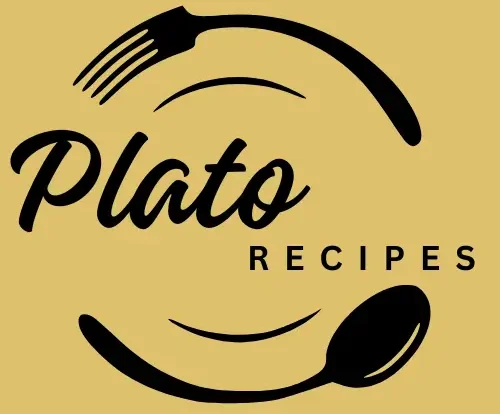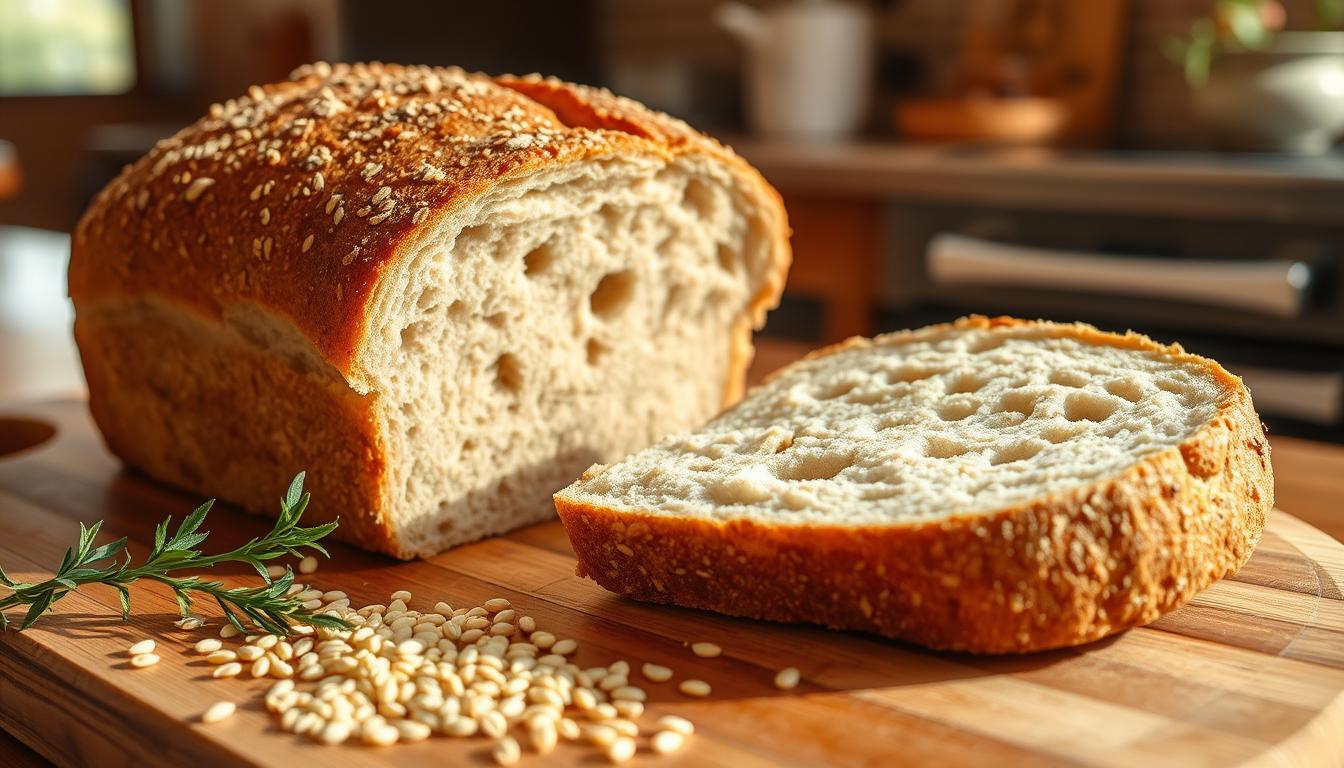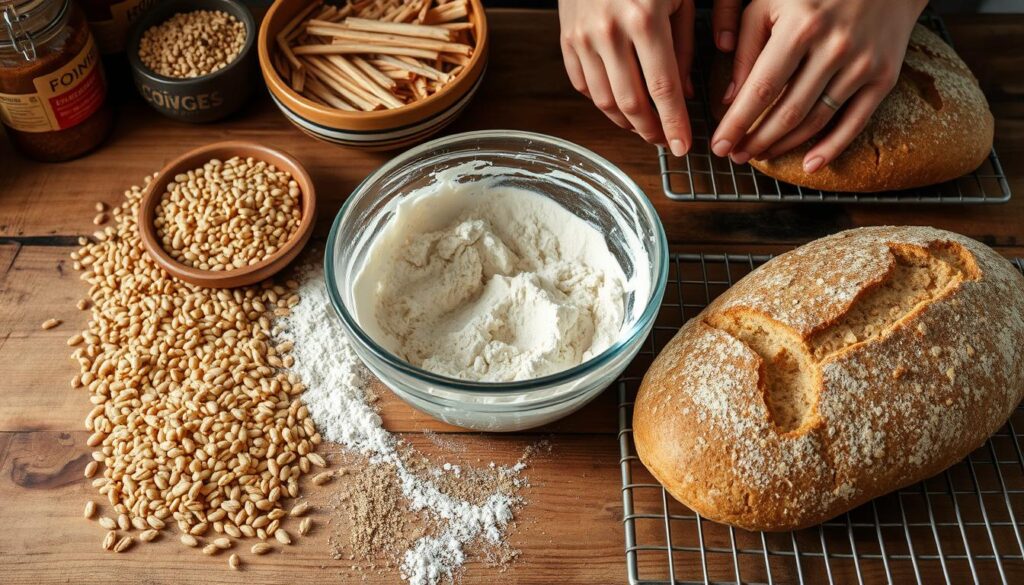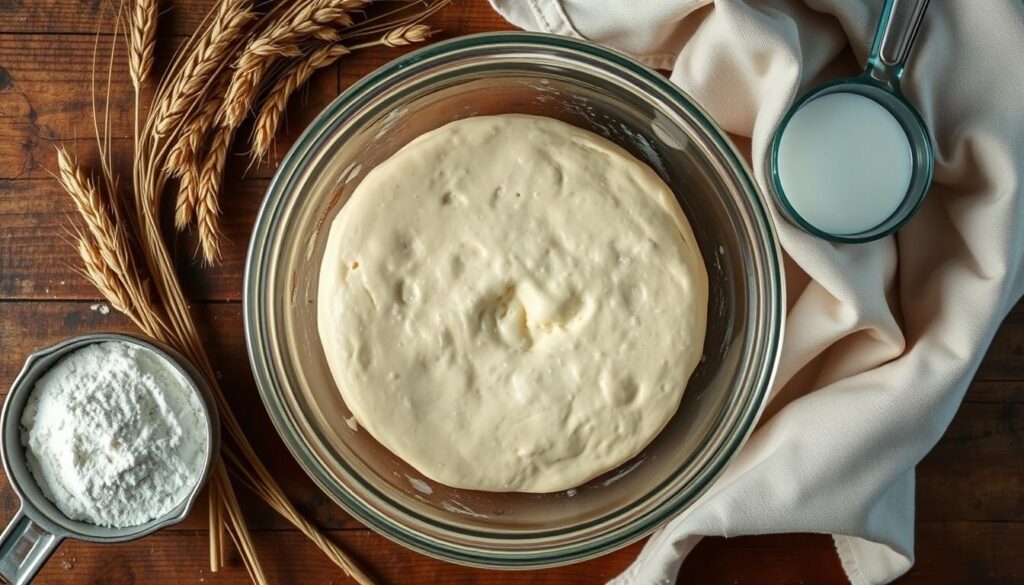The smell of fresh bread always brings back memories for me. As a home baker, I fell in love with einkorn flour. It changed how I bake artisan bread. This einkorn bread recipe is more than just food; it’s a way to connect with old baking traditions.
Imagine baking a healthy bread that tastes amazing and is full of good nutrients. The einkorn bread recipe I’ll share combines ancient grains with modern baking. It makes a loaf that’s both healthy and very satisfying.
This einkorn bread is special because of its unique taste and nutritional benefits. Unlike regular wheat, einkorn has a nutty flavor and is very nutritious. You’re not just making a meal; you’re creating a traditional culinary experience.
Key Takeaways for this Einkorn Bread Recipe
- Discover the nutritional superiority of einkorn flour
- Learn an authentic artisan bread technique
- Create a bread with higher protein and fiber content
- Enjoy a naturally nutty and sweet flavor profile
- Embrace a time-efficient and health-conscious baking method
Understanding Einkorn: The Ancient Grain Revolution
Explore the world of einkorn flour, an ancient wheat that’s been around for thousands of years. It’s a nutritional gem that links us to old farming ways from the Neolithic Revolution.
Einkorn is the oldest wheat type, known for its simple genetic makeup. It has two complete chromosome sets, unlike today’s wheat. This ancient grain is packed with nutrients, making it a great choice for those who care about their health.
Historical Origins and Evolutionary Journey
Wild einkorn was first domesticated about 10,000 years ago. This was a big step in human farming history. It can grow well in tough places like sandy soils and high altitudes, where regular wheat often fails.
- Domesticated during the Neolithic Revolution
- Genetic structure remains largely unaltered
- Grows successfully in marginal agricultural landscapes
Nutritional Profile of this Einkorn Bread Recipe
Einkorn flour is a nutritional powerhouse. It has more protein, zinc, iron, and antioxidants than modern wheat. It also has less gluten, which can be good for people with wheat sensitivities.
- 30% more protein
- Increased levels of zinc and iron
- Higher antioxidant content
- Lower gluten levels
Modern Applications in Baking
In today’s kitchens, einkorn flour is a hit with bakers and health fans. It makes breads and pastries taste different and can be easier to digest. This is great for those who can’t handle regular wheat well.
Einkorn: Bridging ancient agricultural wisdom with modern nutritional needs.
Einkorn’s comeback is more than a food trend. It’s a move towards sustainable, nutrient-rich food that respects our farming roots.
Health Benefits and Dietary Advantages
Discover the amazing health benefits of einkorn, an ancient grain. It’s changing the game for those who care about their health. Unlike modern wheat, einkorn has a special nutritional profile. It’s a superfood for those looking for healthier food choices.
Einkorn offers more than just flour. It’s packed with nutrients:
- More protein than modern wheat
- Full of minerals like iron and zinc
- Has more vitamin B1 and antioxidants
- Less gluten, which may help those with mild gluten sensitivity
For those with digestive problems, einkorn is an interesting choice. It has only 14 chromosomes, unlike modern wheat’s 42. This might make it easier to digest for some with mild gluten sensitivity.
“Einkorn is not just a grain, it’s a nutritional time capsule connecting us to our agricultural roots.” – Nutrition Expert
Einkorn is great for managing blood sugar. It releases glucose slowly, which can keep energy levels stable. This can help with metabolic health. Its natural phenolic acids also protect cells and fight inflammation.
Even though it’s not for those with Celiac disease, einkorn is a big deal for health-conscious people. It offers a new, wholesome option for their diets.
Essential Equipment and Ingredients
Getting ready to make einkorn bread means picking the right tools and ingredients. The quality of your loaf depends on the tools you use and how well you measure ingredients.
Starting your einkorn bread baking journey needs specific kitchen tools. The right tools can greatly improve your bread-making experience.
Essential Kitchen Equipment for this Einkorn Bread Recipe
- Digital kitchen scale for accurate ingredient measurement
- Large mixing bowl with high sides
- Proofing basket (banneton)
- Dutch oven or baking stone
- Bench scraper
- Bread lame or sharp knife for scoring
Sourcing Quality Einkorn Flour
Finding top-notch einkorn flour takes some effort. Look for trusted suppliers in:
- Specialty health food stores
- Online organic retailers
- Local co-op markets
- Direct farm suppliers
Ingredient Measurement Precision
Measuring ingredients accurately is key when using einkorn flour. Weight measurements are much more reliable than volume measurements. A digital kitchen scale is a must for consistent results.
| Ingredient | Recommended Measurement Method |
|---|---|
| Einkorn Flour | Grams (by weight) |
| Salt | Weight measurement |
| Water | Grams or milliliters |
| Yeast | Precise weight measurement |
“Precision in baking is an art form, and with einkorn, every gram counts.” – Artisan Baker’s Wisdom
Choosing the right baking tools and mastering ingredient measurement will prepare you to make delicious einkorn bread. You’ll do it with confidence and skill.
Einkorn Bread Recipe: Step-by-Step Guide
Starting your einkorn bread making journey needs focus and love. This homemade bread recipe turns your kitchen into a cozy bakery. It makes a delicious, healthy loaf that’s different from regular wheat breads.
Before you start baking, make sure you have all your ingredients ready. The quality of your ingredients and how well you prepare them are key to making great einkorn bread.
Ingredients You’ll Need
- 500 grams fresh milled einkorn flour
- 1 1/3 cups warm water (115°F)
- 9 grams instant yeast
- 1 tablespoon maple syrup
- 1 teaspoon salt
- 1 tablespoon apple cider vinegar
Mixing and Kneading
- Activate yeast in warm water with maple syrup
- Combine dry ingredients in a large mixing bowl
- Gradually add wet ingredients
- Knead dough for 10 minutes until it’s smooth
Einkorn flour is special because it has weak gluten. This means you need to handle the dough gently.
“Baking is love made visible” – Unknown
Nutritional Breakdown
| Nutrient | Amount per Serving |
|---|---|
| Calories | 112 |
| Protein | 4g |
| Carbohydrates | 24g |
| Fiber | 3g |
| Iron | 1mg |
Your homemade bread will taste mild and nutty, better than store-bought loaves. With practice, you’ll get better at making einkorn bread. You’ll make delicious, healthy bread every time.
Mastering the Art of Dough Hydration
Baking with einkorn flour needs a deep understanding of dough hydration. This ancient grain is different from modern wheat. It requires special techniques to get the right bread texture.
Dough hydration is key when using einkorn flour. Unlike modern wheat, einkorn flour absorbs water differently. This affects the bread’s quality.
Understanding Water-to-Flour Ratios
When making einkorn bread, focus on the water-to-flour ratio. The best hydration for einkorn is between 75-85%. This is a bit lower than what you use for wheat flour.
- Start with about 525g of water for 700g of einkorn flour
- Adjust the liquid a little at a time to get the right dough consistency
- Use a digital scale for exact measurements
Adjusting for Climate and Humidity
Einkorn flour absorbs water differently based on the environment. You need to adjust your baking for local humidity and temperature.
“Patience and observation are key when working with einkorn dough.” – Artisan Baker
In dry places, you might need to add a bit more water. But in humid areas, you might need to use less water. This prevents the dough from being too sticky. Always check the dough’s texture while mixing and kneading.
Creating great einkorn bread comes down to mastering these hydration details. Try different things and keep track of what works for you. This will help you develop your own baking style.
Fermentation and Proofing Techniques
Bread fermentation is key to making delicious einkorn bread. Unlike modern wheat, einkorn needs special care during dough proofing. The bread’s taste, texture, and how well it’s digested depend on these techniques.
Knowing the einkorn rising time is vital for the perfect loaf. This ancient grain’s unique traits require patience in fermentation.
“Patience is the secret ingredient in transforming einkorn flour into an exceptional loaf of bread.”
Key Fermentation Guidelines for this Einkorn Bread Recipe
- Total fermentation time: 8-10 hours
- Room temperature fermentation: 3-5 hours
- Dough volume increase: Approximately 30%
Proofing Techniques
| Stage | Time | Temperature |
|---|---|---|
| Bulk Fermentation | 2-4 hours | Room temperature |
| Final Proofing | 60-90 minutes | Room temperature |
| Cold Fermentation | Up to 8 hours | Refrigerator |
For better flavor, try overnight cold fermentation. Mix your dough in the morning. Let it ferment all day, then refrigerate in a banneton at night. This slow rise makes the bread’s flavors deeper and easier to digest.
Don’t forget to gently stretch and fold the dough during bulk fermentation. This helps build strength and structure in your einkorn dough. Your patience will pay off with a loaf that’s nutty and full of flavor, celebrating the ancient grain’s special qualities.
Baking Temperature and Timing Guidelines
Getting your einkorn bread just right means paying close attention to temperature and time. The right steps can turn a good loaf into an amazing one, especially when it comes to the crust.
Optimal Oven Settings
To make perfect einkorn bread, you need to manage the temperature well. Recipes usually suggest baking at 350°F to 450°F. This depends on the recipe and what you want your bread to be like.
- Low-temperature method: 350°F for 30-40 minutes
- High-temperature method: 450°F for 30 minutes covered, 30 minutes uncovered
- Moderate approach: 375°F for 50 minutes
Visual Cues for Perfect Doneness
The look of your bread can tell you if it’s baked well. Here are the signs of a perfectly baked loaf:
- Deep golden-brown exterior color
- Crisp, crackling crust
- Hollow sound when tapped on the bottom
- Internal temperature of 200°F (93°C)
“The art of bread baking is as much about patience as it is about precision.” – Artisan Baker
| Flour Type | Baking Temperature | Baking Time |
|---|---|---|
| All-Purpose Einkorn | 350°F | 30 minutes |
| Whole Wheat Einkorn | 375°F | 50 minutes |
| Sourdough Einkorn | 450°F | 60 minutes (30 covered, 30 uncovered) |
Remember, crust development is a delicate art. Your oven and the einkorn flour you use might change these guidelines a bit. Always listen to your gut and watch for visual signs.
Troubleshooting Common Baking Issues
Baking this einkorn bread recipe can be tricky, even for seasoned bakers. Knowing common problems helps you avoid them and make great loaves.
The dough’s consistency is key. Einkorn acts differently than modern wheat, needing careful attention to how wet it is and how you handle it.
- Sticky Dough Solutions:
- Use wet hands when handling the dough
- Reduce overall hydration by 10-15%
- Allow dough to rest for 15-20 minutes before final kneading
- Density Troubleshooting:
- Ensure proper fermentation time
- Avoid overworking the dough
- Check yeast freshness and activity
Understanding your ingredients is crucial for bread troubleshooting. Einkorn flour soaks up liquid differently than modern wheat. So, be patient and watch closely.
“Baking is a science, but bread is an art.” – Unknown Baker
Temperature and humidity are important for bread success. Warm places speed up fermentation, while cool ones slow it down. Keep an eye on these factors to adjust as needed.
| Issue | Potential Cause | Solution |
|---|---|---|
| Low Rise | Inactive Yeast | Replace yeast, check expiration |
| Dense Texture | Insufficient Proofing | Extend fermentation time |
Every baking challenge is a chance to get better and learn about einkorn flour’s special traits.
Storage and Preservation Methods
Keeping your homemade einkorn bread fresh is key. The right storage methods can make your bread last longer. This helps keep its taste and texture just right.
Let your einkorn bread cool completely on a wire rack after baking. This step is important. It stops moisture from building up and keeps your bread fresh.
Short-Term Preservation Strategies
- Store at room temperature in a paper bag or bread box
- Keep bread fresh for 3-5 days
- Avoid plastic bags that trap moisture
Long-Term Storage Solutions for this Einkorn Bread Recipe
Freezing is a great way to keep your bread fresh for longer. Slice the bread before freezing. This makes it easier to thaw and use.
| Storage Method | Duration | Best Practices |
|---|---|---|
| Room Temperature | 3-5 days | Use paper bag or bread box |
| Freezer Storage | Up to 3 months | Slice before freezing, use freezer-safe bags |
Refreshing Stored Bread
To make stored einkorn bread fresh again, lightly toast or warm it in the oven. Avoid refrigeration, as it makes bread stale faster.
“Proper storage is the secret to enjoying fresh, delicious bread days after baking.” – Artisan Bread Experts
By using these tips, you can make your einkorn bread last longer. Enjoy every slice at its best.
Recipe Variations and Flavor Enhancements
Exploring einkorn bread variations opens up a world of culinary creativity. Your artisan bread recipes can transform with simple yet exciting flavor additions. These additions elevate the traditional einkorn loaf.
Start your flavor journey with these exciting mix-ins:
- Seeded Einkorn Bread: Incorporate pumpkin seeds, sunflower seeds, and chia seeds for added nutrition and crunch
- Herb-Infused Loaves: Blend in fresh rosemary, thyme, or oregano for savory depth
- Sweet Variations: Create cinnamon raisin or dried fruit versions with minimal added sugar
Experiment with different techniques to enhance your einkorn bread’s texture and taste. Adjusting hydration levels can dramatically change your bread’s final character. A slightly wetter dough typically results in a softer, more tender crumb.
“Baking is an art of patience and creativity – especially with ancient grains like einkorn.” – Artisan Baker
For sourdough enthusiasts, einkorn flour offers unique fermentation possibilities. The typical fermentation period ranges from 12-24 hours, allowing complex flavors to develop. Keep salt content between 1.8% to 2% of total flour weight for balanced taste.
- Recommended oven temperature: 475°F (245°C)
- Typical fermentation time: 12-24 hours
- Salt percentage: 1.8% – 2% of flour weight
Your einkorn bread variations can showcase incredible versatility while maintaining the grain’s nutritional integrity. Whether you prefer savory herb loaves or sweet fruit-studded creations, einkorn provides an excellent canvas for culinary expression.
Conclusion
Your journey into einkorn baking is more than just cooking. It’s a chance to make your home baking healthier and tastier. Einkorn flour is a great alternative to regular wheat flour.
It connects you to a long history of farming. This ancient grain makes your bread more nutritious and flavorful.
Using einkorn flour for baking is good for your health. It has less gluten and more protein than other grains. This makes it easier to digest.
By following this guide, you can make the best einkorn bread recipe in your kitchen. It’s a way to nourish yourself with delicious, homemade bread, which makes astonish combination with farmers cheese, plum jelly or sunny side up egg.
Einkorn bread making is not just about recipes. It’s a chance to try new things, learn, and create something unique. Each loaf you make connects you to old baking traditions.
It also links you to the history of einkorn, one of the oldest grains grown by humans.
As you keep baking with einkorn, remember that patience and practice are key. Your skills will grow with each loaf. The taste and health benefits are worth the effort.
Enjoy the journey, appreciate the results, and dive into the world of einkorn bread making.
FAQ
What is einkorn flour, and how is it different from regular wheat flour?
Einkorn flour is the oldest wheat type, dating back thousands of years. It has less gluten and a unique protein structure. It’s also more nutrient-dense, with more protein, vitamins, minerals, and antioxidants.
Is einkorn bread suitable for people with gluten sensitivity?
Einkorn might be easier for those with mild gluten sensitivities. But, it’s not gluten-free. People with celiac disease should avoid it. Always talk to a doctor about gluten concerns.
How does baking with einkorn flour differ from baking with regular flour?
Einkorn flour absorbs less liquid and needs special baking techniques. It needs less water and longer fermentation times. The dough is delicate and sticky, so you’ll need to adjust your handling.
What are the main health benefits of this einkorn bread recipe?
Einkorn bread has more protein and fiber, and more nutrients like vitamin B1 and iron. It also has more antioxidants. It’s a healthier choice than regular wheat bread.
How should I store einkorn bread to maintain its freshness?
Keep einkorn bread at room temperature in a paper bag or bread box for 2-3 days. Slice and freeze for up to 3 months if you want to keep it longer. Don’t refrigerate, as it stales faster. Refresh by lightly toasting or warming in the oven.
Can I create different variations of this einkorn bread recipe?
Yes! Add seeds, nuts, dried fruits, herbs, or spices to enhance einkorn bread. Try seeded einkorn loaf, cinnamon raisin einkorn bread, or sourdough einkorn bread. These variations offer different flavors while keeping the nutritional benefits.
What equipment do I need to bake this einkorn bread recipe at home?
You’ll need a large mixing bowl, proofing basket, baking stone or Dutch oven, and a kitchen scale. A kitchen scale is key for consistent results, as weight measurements are better than volume with einkorn flour.
What temperature and time are best for baking this einkorn bread recipe?
Bake einkorn bread at 450°F (230°C) for 30-45 minutes, depending on size. Use a baking stone or Dutch oven for a crisp crust. It’s done when it’s 200°F (93°C) inside and has a deep golden color with a hollow sound when tapped.



